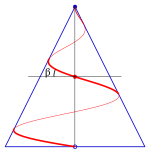
Conical spiral with Archimedean spiral as a plan

Ground plan: Fermatsche spiral

Ground plan: logarithmic spiral

Ground plan: hyperbolic spiral
A conical spiral is a curve on a perpendicular circular cone , the outline of which is a plane spiral . If the ground plan is a logarithmic spiral , it is called a concho spiral, derived from conch (water snail).
Like the logarithmic spiral itself, the concho spiral constructed with it also plays a role in biology in the modeling of snail shells , in insect flight and in technology in the construction of broadband antennas .
Parametric representation
Is in the - level through the parametric representation



Given a plane spiral, a third coordinate can be added so that the resulting spatial curve lies on the vertical circular cone with the equation :



Curves of this type are called conical spirals and the plane spiral used for construction is their plan. They were already known to Pappos .
The parameter is the slope of the taper line compared to the - plane.



The conical spiral can also be viewed as an orthogonal projection of the ground plan spiral onto the surface of the cone.
- Examples
-
1) Assuming an Archimedean spiral , the conical spiral is obtained (see picture)


- In this case, the conical spiral can also be understood as the intersection of a cone and a helical surface .
-
2) The second picture shows a conical spiral with a Fermat's spiral as a plan.

-
3) The third example has a logarithmic spiral as a floor plan. It is characterized by a constant slope (see below).

-
4) In this example the floor plan is a hyperbolic spiral . It has an asymptote (black straight line). This asymptote is the outline of a hyperbola (purple), which the conical spiral for approximates.


properties
Properties of conical spirals with outlines of the shape or are specified below:


pitch

Pitch angle at one point of a conical spiral
The slope of a conical spiral is the slope of the spiral (tangent) relative to the horizontal ( - plane). The associated gradient angle is (see picture):




For a spiral with :


For an Archimedean spiral, and therefore the slope

- For a logarithmic spiral with is ( ).



A concho spiral is therefore also called an equiangular conical spiral.
Arc length
The length of an arc of a curve in a conical spiral is

For an Archimedean spiral, the occurring integral, as in the plane case, can be solved with the help of an integration table.
![{\ displaystyle L = {\ frac {a} {2}} {\ big [} \ varphi {\ sqrt {(1 + m ^ {2}) + \ varphi ^ {2}}} + (1 + m ^ {2}) \ ln {\ big (} \ varphi + {\ sqrt {(1 + m ^ {2}) + \ varphi ^ {2}}} {\ big)} {\ big]} _ {\ varphi _ {1}} ^ {\ varphi _ {2}} \.}](https://wikimedia.org/api/rest_v1/media/math/render/svg/6334ca334c1e5bd98e74044ae99f7a9802c3b125)
For a logarithmic spiral, the integral can easily be solved:

In other cases, elliptic integrals can occur.
completion

Development (green) of a conical spiral (red), right: side view. The settlement level is . At first it touches the cone in the purple straight line.

For the development of a conical spiral, the distance between a curve point and the tip of the cone and the relationship between the angle and the angle in the development must be determined:







The polar representation of the developed conical spiral is:

The development in the case is the curve in polar representation


a coil of the same type. Specifically:
- If the outline of a conical spiral is an Archimedean spiral, the development is also an Archimedean spiral.
- In the case of a hyperbolic spiral ( ), the development is even congruent to the floor plan.

In the case of a logarithmic spiral with , the development is the logarithmic spiral


Tangent track

Conical spiral with hyperbolic spiral as a floor plan: tangent track (purple circle). The black straight line is the asymptote of the hyperbolic spiral.
The intersection of the tangents of a conical spiral with the - plane (plane through the tip of the cone) is called the tangent track.

For the conical spiral

is the tangent vector

and the tangent:



The intersection of the tangent with the - plane has the parameter and is




For is and the tangent track again a spiral, which, however, in the case (hyperbolic spiral) to a circle of radius degenerate (see picture). For is and the track again congruent to given logarithmic spiral spiral (for self-similarity of a logarithmic spiral ).






Individual evidence
-
^ New Scientist
-
^ Conchospirals in the Flight of Insects
-
↑ John D. Dyson: The Equiangular Spiral Antenna. In: IRE Transactions on Antennas and Propagation. Vol. 7, 1959, pp. 181-187.
-
^ TA Kozlovskaya: The Concho-Spiral on the Cone. Vestn. Novosib. Gos. Univ., Ser. Mat. Mekh. Inform., 11: 2 (2011), 65-76.
-
^ Siegmund Günther, Anton Edler von Braunmühl, Heinrich Wieleitner: History of mathematics. GJ Göschen, 1921, p. 92.
-
↑ Theodor Schmid: Descriptive Geometry. Volume 2, Association of Scientific Publishers, 1921, p. 229.
Web links





























![{\ displaystyle L = {\ frac {a} {2}} {\ big [} \ varphi {\ sqrt {(1 + m ^ {2}) + \ varphi ^ {2}}} + (1 + m ^ {2}) \ ln {\ big (} \ varphi + {\ sqrt {(1 + m ^ {2}) + \ varphi ^ {2}}} {\ big)} {\ big]} _ {\ varphi _ {1}} ^ {\ varphi _ {2}} \.}](https://wikimedia.org/api/rest_v1/media/math/render/svg/6334ca334c1e5bd98e74044ae99f7a9802c3b125)
























